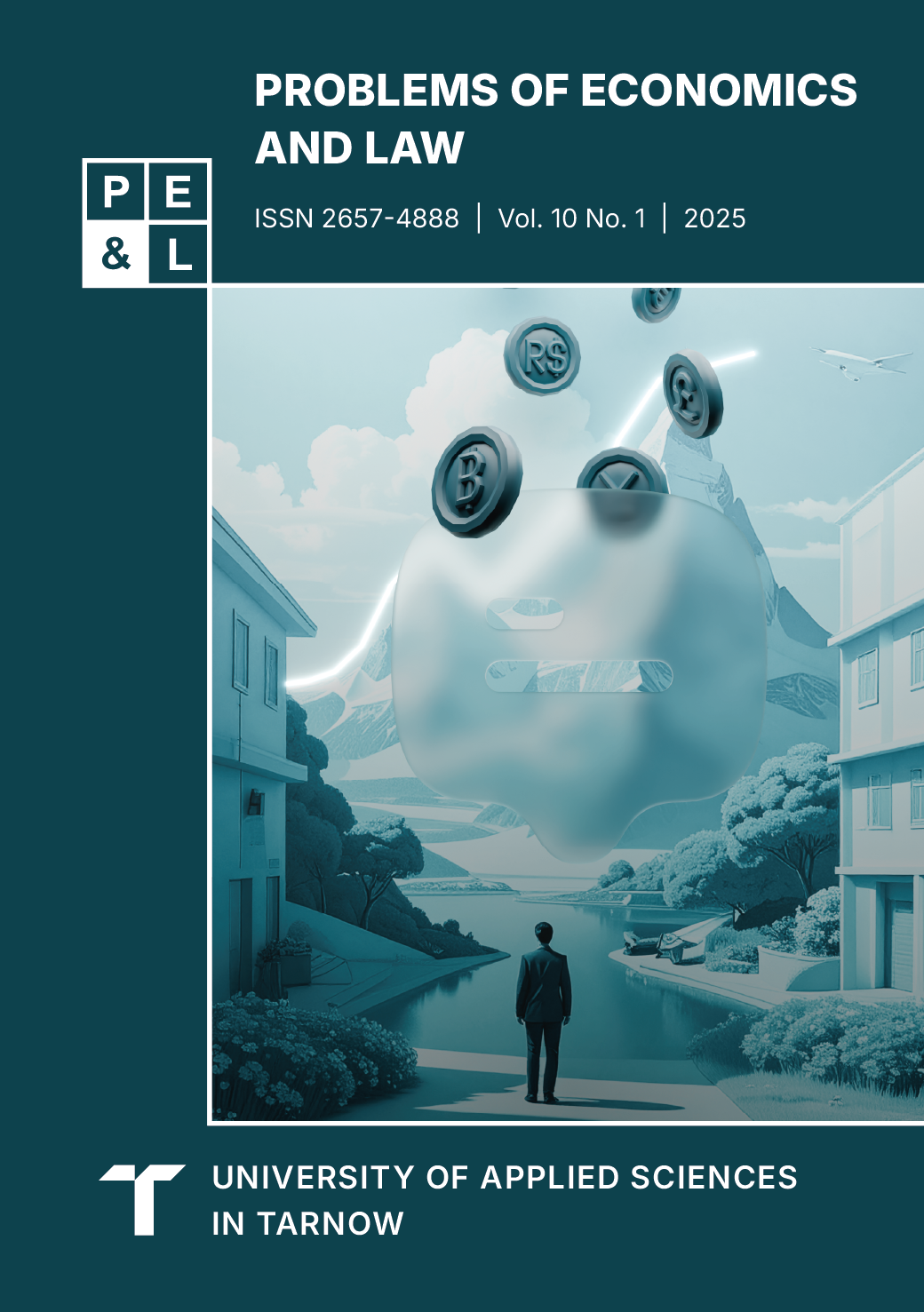Social expenditure in European Union countries
DOI:
https://doi.org/10.55225/pel.644Keywords:
ranking, European Union, social expendituresAbstract
Purpose of the article: The aim of the research was to identify the occurrence of convergence between the social needs and possibilities of the European Union countries and the implemented social expenditure. In addition, the specific aim is to establish a ranking of the European Union countries in terms of the amount of implemented expenditure on social purposes and the place of Poland in this ranking.
Material and methods: The research material was obtained from the websites of the Central Statistical Office and Eurostat. The linear correlation coefficients were calculated between the amount of expenditure on social purposes and the poverty risk indicator, between the amount of expenditure on social purposes and the amount of GDP per capita in PPS, and between the amount of GDP and the share of social expenditure in GDP and between the amount of the poverty risk indicator and the share of social expenditure in GDP. Additional study of the grouping of EU countries based on their correlation profiles using cluster analysis.
Results and conclusions: The social expenditure implemented by individual European Union countries was strongly diversified. The highest expenditure per capita was recorded in Luxembourg, and the lowest in Bulgaria. In this respect, the division into the richer – old EU member states and the less affluent countries of Central and Eastern Europe was clearly visible. In Poland, one of the lowest expenditures was implemented in terms of amounts. The implemented expenditures showed a strong correlation with the resilience of the economy, measured by the level of gross domestic product (correlation coefficient 0.78) and a weak correlation with social needs measured by the poverty risk indicator (correlation coefficient −0.27), which indicates a greater importance of the ability of individual countries to implement social expenditures than of social needs themselves.
Downloads
References
Aczel, A.D., Sounderpandian, J. (2009). Complete Business Statistics. McGraw Hill. Google Scholar
Bankier.pl. (2025). EUR/USD: kurs EUR/USD Forex. Dostępny w Internecie: https://www.bankier.pl/waluty/kursy-walut/forex/EURUSD [dostęp: 2025-03-30]. Google Scholar
Bednarz, M. (2014). Zabezpieczenie społeczne jako instrument realizacji bezpieczeństwa socjalnego. Prace Naukowe Wyższej Szkoły Bankowej w Gdańsku, 33, 151–170. Google Scholar
Ciżmowska, A. (2006). Spory o europejskie państwo opiekuńcze. W: Świat idei i polityki. T. 6. (s. 141–158). Bydgoszcz: Akademia Bydgoska im. Kazimierza Wielkiego. Instytut Nauk Politycznych. Google Scholar
Drab, K. (2015). Metody grupowania danych i ich wybrane modyfikacje dedykowane eksploracji danych eksperymentalnych. Katowice: Uniwersytet Śląski. Google Scholar
Eurostat. (2024a). Expenditure on social benefits by function. Dostępny w Internecie https://ec.europa.eu/eurostat/databrowser/view/spr_exp_func/default/table [dostęp: 2024-09-11]. Google Scholar
Eurostat. (2024b). Statistics explained. Dostępny w Internecie: https://ec.europa.eu/eurostat/statistics-explained/ [dostęp: 2024-09-11]. Google Scholar
GUS. (2022). Rocznik Statystyki Międzynarodowej 2022. Dostępny w Internecie: https://stat.gov.pl/obszary-tematyczne/roczniki-statystyczne/roczniki-statystyczne/rocznik-statystyki-miedzynarodowej-2022,10,10.html/ [dostęp: 2024-09-10]. Google Scholar
GUS. (2024). Rocznik Statystyczny Rzeczypospolitej Polskiej 2024. Warszawa: Główny Urząd Statystyczny. Google Scholar
Guziejewska, B. (2023). Wydatki publiczne w Polsce na tle wydatków publicznych i ich zmian w krajach Unii Europejskiej – z perspektywy pandemii COVID-19. Myśl Ekonomiczna i Polityczna, 3(78), 141–161. Google Scholar
Kańduła, S. (2010). Przyczyny wzrostu wydatków lokalnych. Prace Naukowe Uniwersytetu Ekonomicznego we Wrocławiu: Finanse publiczne, 112, 254–268. Google Scholar
Kafle, S.C. (2019). Correlation and regression analysis using SPSS. OCEM Journal of Management, Technology and Social Sciences, 126–132. Google Scholar
Kijek, I. (2011). Dług publiczny a wydatki społeczne w państwach Unii Europejskiej. Prace Naukowe Uniwersytetu Ekonomicznego we Wrocławiu: Finanse – nowe wyzwania teorii i praktyki. Finanse publiczne, 173, 271–282. Google Scholar
Kokoszkiewicz, A. (2015). Opieka społeczna jako zadanie państwa. Lublin: Wydawnictwo Europejskiej Fundacji Przedsiębiorczości. Google Scholar
Mikuła, A. (2011). Poziom ubóstwa w Polsce w ujęciu regionalnym. Roczniki Naukowe Stowarzyszenia Ekonomistów Rolnictwa i Agrobiznesu, 13(3), 198–203. Google Scholar
Milewski, R. (red.). (2012). Elementarne zagadnienia ekonomii. Warszawa: Wydawnictwo Naukowe PWN. Google Scholar
Murtagh, F., Legendre, P. (2014). Ward’s hierarchical agglomerative clustering method: Which algorithms implement ward’s criterion? Journal of Classification, 31, 274–295. Google Scholar
Płonka, M. (2015). Ekonomia społeczna a koncepcje polityki społecznej państwa: model polski. Ekonomia Społeczna, 2, 85–100. Google Scholar
Sejm Rzeczypospolitej Polskiej. (2024). Dostępny w Internecie: https://www. sejm.gov.pl/ [dostęp: 2024-03-10]. Google Scholar
Stańko, A. (2010). Wielkość oraz struktura wydatków społecznych w krajach Unii Europejskiej. Prace Naukowe Uniwersytetu Ekonomicznego we Wrocławiu, 112, 726–739. Google Scholar
Świątkowski, A. (2005). Przyszłość państwa opiekuńczego z perspektywy europejskiej. Polityka Społeczna, 11–12, 10–15. Google Scholar
Zalewska, E. (2017). Zastosowanie analizy skupień i metody porządkowania liniowego w ocenie polskiego szkolnictwa wyższego. Prace Naukowe Uniwersytetu Ekonomicznego we Wrocławiu: Taksonomia, 469, 234–242. DOI: 10.15611/pn.2017.469.24. Google Scholar
Żukowski, M. (2017). Wydatki socjalne w Polsce na tle UE. Polityka Społeczna, 521(8), 10–17. Google Scholar
Downloads
Published
How to Cite
Issue
Section
License
Copyright (c) 2025 Jarosław Mikołajczyk, Wojciech Sroka, Marcin Stanuch

This work is licensed under a Creative Commons Attribution-ShareAlike 4.0 International License.





